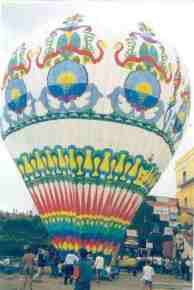
The hot-air balloon was the first flying machine constructed
by man. With this the conquest of the skies began, formerly the uncontested
domain of the birds. It is extraordinary in its simplicity: a bubble of hot air
that ascends into the sky, carrying with it a skin that holds it prisoner.
In Italy and in other countries there is an antique and wide-spread tradition
with regard to the "paper hot-air balloons", constructed by skillful
craftsmen for feasts of patron saints of towns and villages. In 1994, thanks
above all to the passion and enthusiasm of its present president Giuseppe Ietto
of Civitella del Tronto, the A.R.I.A. was established, the first and only
association in Italy that has as its goal the recovery of the historical
realities, some of which are very old, relative to this hot-air balloon modeling,
and to the diffusion and the technical development, of the art and culture in
general, to which it is tied.
ACTIVITV CONNECTED
TO THE MINI HOT-AIR BALLOON
· Decoration
· Special forms
· Historical modeling
· Flight
· Aerial photography
· Research
· Didactic
CATEGORIES
On the basis of volume, hot-air balloons are distinguished as follows:
· Class A: Mini hot-air balloons or indoor hot-air balloons ( balloon volume up to 1 cubic meter)
· Class B: Small hot-air balloons (volume of the covering up to l0 cubic meters)
· Class C: Medium hot-air balloons (volume of the covering up to 100 cubic meters.
· Class D: Large hot-air balloons (volume of the covering greater than 100 cubic meters)

DECORATION
In the past hot-hair balloons were richly decorated for the feast days of town patrons by skillful artists, content on showing to the crowds gathered around the balloon, the paintings (at times valuable) that took form with the inflation of the balloon segments. The artists were pleased, even though in just a few minutes the fruit of weeks of patient work is lost into nothing, according to the destiny of the balloon that flies away at the mercy of the winds to unknown destinations.
To preserve this antique tradition, A.R.I.A. has begun a national competition of "hot-air balloon decoration" that has had enormous success, taking part in every area of art, school, and society.
The association provides the participants with the balloon segments to decorate, and then later provides for the assembly. The interest and the originality of this activity is in the particular type of surface that, instead of being flat like the canvas of a painting or the wall of a fresco, is on the other hand is spherical and is developed in three dimensions of space, turning around on itself.
The judges of the hot-air balloon decoration competitions are advised to take in to account the following peculiarities of pictorial design:
· As much as the designs are beautiful, but are "living" on every segment without any connection with the adjacent segments, they lose the essence of the competition itself (fig.2).
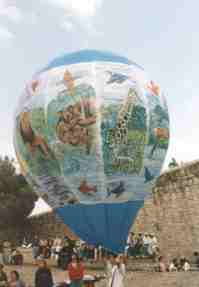
· It is completely acceptable that works exploit the segments of the covering to create rhythmic composition (fig.3).
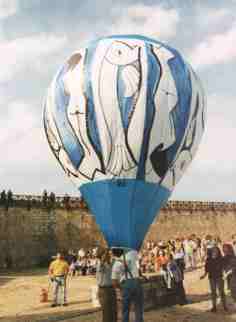
· The designs themselves are in harmony wiyh the balloon segments that unravel themselves, and disappear in the face of the unity of the design (fig.4).
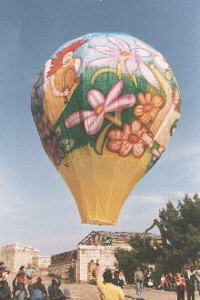
SPECIAL FORMS
It is a specific field where forms are based on projected capacity and
pratical ability. The skin takes the form of objects, animals, or takes
shape in interesting geometric designs. Paraphrasing a mathematical concept,
we could say that the "hot-air balloon decoration" is to the painting
as the
"special forms" are to the sculpture.
Of course every creation must have characteristics of structural resistance
and of stability, treating it in every case as a flying machine.
While in hot-air balloon decorating, the ability that becomes obvious is
only of an esthetic type, givin the hot-air balloon a pure role of support,
in the special forms the technical abilities are given considerable
importance (these can present considerable structural problems) and need to
taken into account.
In case of competitions, the following elements need to be considered:
· Resemblance to the object being represented (beauty of the form in case of
abstract forms)
· Harmony of form and accuracy of execution
· Adopted technical solutions
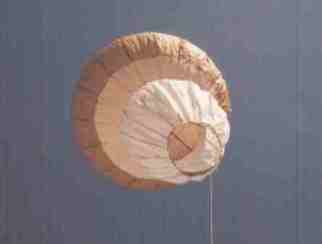
HISTORICAL MODELING
Another interesting activity is that of reproduction in scale of giant
hot-air balloon models (compressed dirigibles) that have marked the history
of hot-air ballooning. Next to faithfulness to the original and
constructive accuracy, a distinction needs to be made between non-flyng
models and those capable of flight:
· Static modeling
· Dynamic modeling
FLIGHT
For the technical part, refer to the book "The book of hot-air balloons (Il libro delle mongolfiere)"- by Enrico Maddalena, published by Il Castello, Milan
It is in the nature of hot-air ballooning itself to float free and easily in
the blue sky and it is exactly in flight that these simple and stupendous paper
balloons always enchant young and old alike.
The possible forms of flight are classified as follows:
· Ancored flight
· Free flight
Free flight can be further subdivided as follows:
· Flight with onboard flame
· Flight without onboard flame
Every form of flight is dependent upon obtaining the required permission from the proper authorities. The hot-air balloon must be constructed perfectily and placed in flight by a competent expert.
The intrinsic parameters that measure the stability and the in-flight safety of a hot-air balloon are listed as follows:
· Low surface to volume ratio
· Low equilibrium temperature
· Center of the hot-air balloon higher than center of gravity
· Reasonable distance between the center of thrust and the center of gravity (it is recommended not to go below 15% of the height of the balloon when inflated). Such a distance is intended to hot-air balloons without combustible loads
· Presence of "fire protective rings" for the mouth of the balloon for those flights with on-board flame
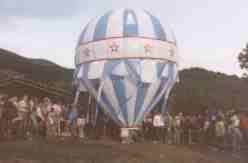
The intrinsic conditions necessary for a safe flight are listed as:
No wind or wind with a velocity not greater than 5 kilometers per hour (one
degree Beaufort)
Launch site at a distance from electrical lines, higth vegetation, buildings
Far away from airports and air lines
Far away from streets and highways
Far away from forests and inflammable materials storage
The ground must be cleaned and free from incendiary ground cover
The spectators must be kept a proper distance (by barriers and by personnel)
With flights equipped with on-board flame (where there is the permission of the
authorities, the duration should be limited (it is recommended to not exceed 15
minutes)
Pre launch of a little helium-filled balloon (probe balloon) with the aim of
determining wind direction at an altitude and study the probable route of the
balloon on a topographic map of the area (example on page I.M.G.I.)
In an anchored flight the hot-air balloon is ancored to the ground by means of a
cable of the appropriate material and length. The length of the cable should not
be greater than 40 meters.
Possible types of competitive connected to free and anchored flights:
Hot-air balloon chasing
Length of flight
Altitude of flight
Time to achieve a height of 40 meters
In the hot-air balloon chase a class B or C hot-air balloon, without an on-board
flame, is anchored to the ground. The first team to recover the balloon is the
winner.
In the length-of-flight competition, the hot-air balloon (of a predetermined
volume, maximum tolerance of 10%) remains in flight, anchored with a standard
cable and filled with fuel supplied by the judges.
In the altitude competition, the hot-air balloon (of a predetermined volume,
maximum tolerance of 10%) is put into anchored flight with a cable supplied by
the judges. The cable should have a relatively high weight (in grams per meter).
In the speed-of-assent competition the time is measured to the moment in which
the tension of the anchoring cable, with a standard length of 40 meters, is
reached. Upon lift-off, the hot-air balloon basket link must be 2 meters form
ground-level. Competition hot-air balloons must all have the same predetermined
volume (tolerance of 10%). The form, on the other hand is optional.
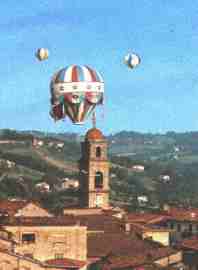
AERIAL PHOTOGRAPHY
Excellent aerial photography can be obtained (of smaller areas if given a lower achieved height), suspending, in an opportune manner at the side of the skin, a time-controlled or remote-controlled camera. With a small video camera, short films can be made.
RESEARCH
Among the principle objectives of hot-air ballooning are those of improving
security and efficiency of the hot-air balloon.
As an example of an original solution recall the "fire-protective-ring"
(E. Maddalena, "Il libro delle mongolfiere" and at the rapid-closure
system at the mouth of the covering, to improve the efficiency of free-flight
with no on-board flame (E. Maddalena, Il bollettino dell'ARIA/_The bulletin of
the ARIA n° 10).
So that the results of every research study can become public property, it is
opportune that they be made available to everybody through their publication in
the bulletin of the ARIA.
Research activity are also those of an historic type, through the gathering of
material, pictures, and methods that should not be lost, even if only for
cultural motives.
DIDACTICS
The construction and flight of hot-air balloon are activities that can find a
useful place in the teaching/educational environnement. It can be included in
the arts, mathematics, geometry, science, technical applications, history and
geography. Pratically all teachers can collaborate in a single project that can
involve and excite the students. Therefore it is opportune that all the hot-air
balloon enthusiasts, and the ARIA members themselves, collaborate with schools,
furnishing them with all the support necessary.
Obviously working at different levels of complexity can be involved in all
schools, from elementary to high school. Also in this environment, referring to
the association, it is good that all the experience is made known so that
everyone can benefit and obtain always more efficient instruments that operate
for better.